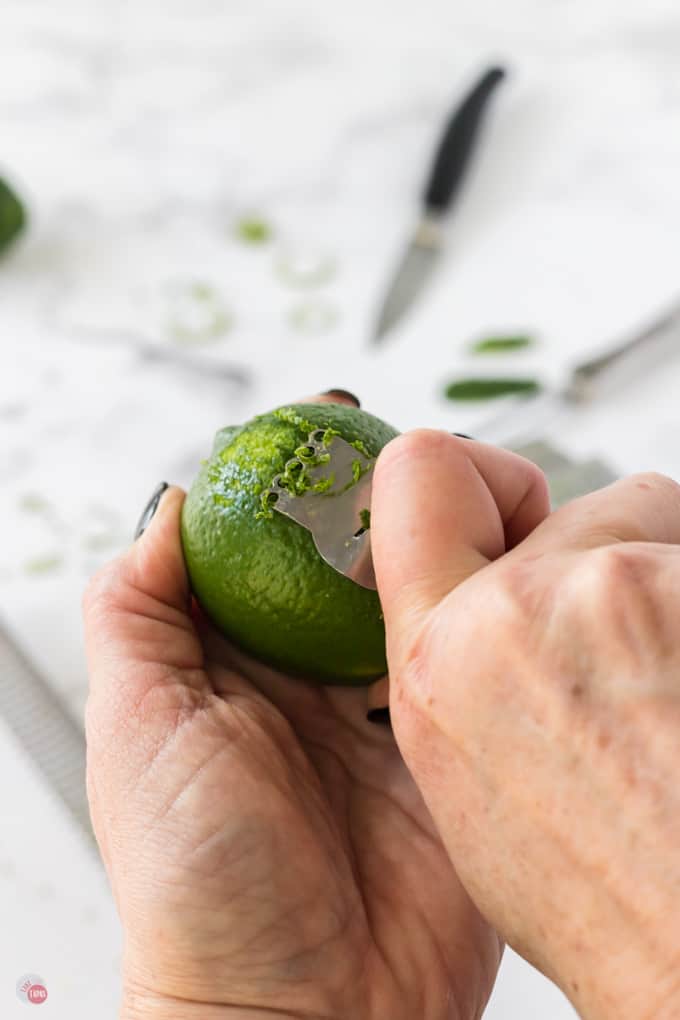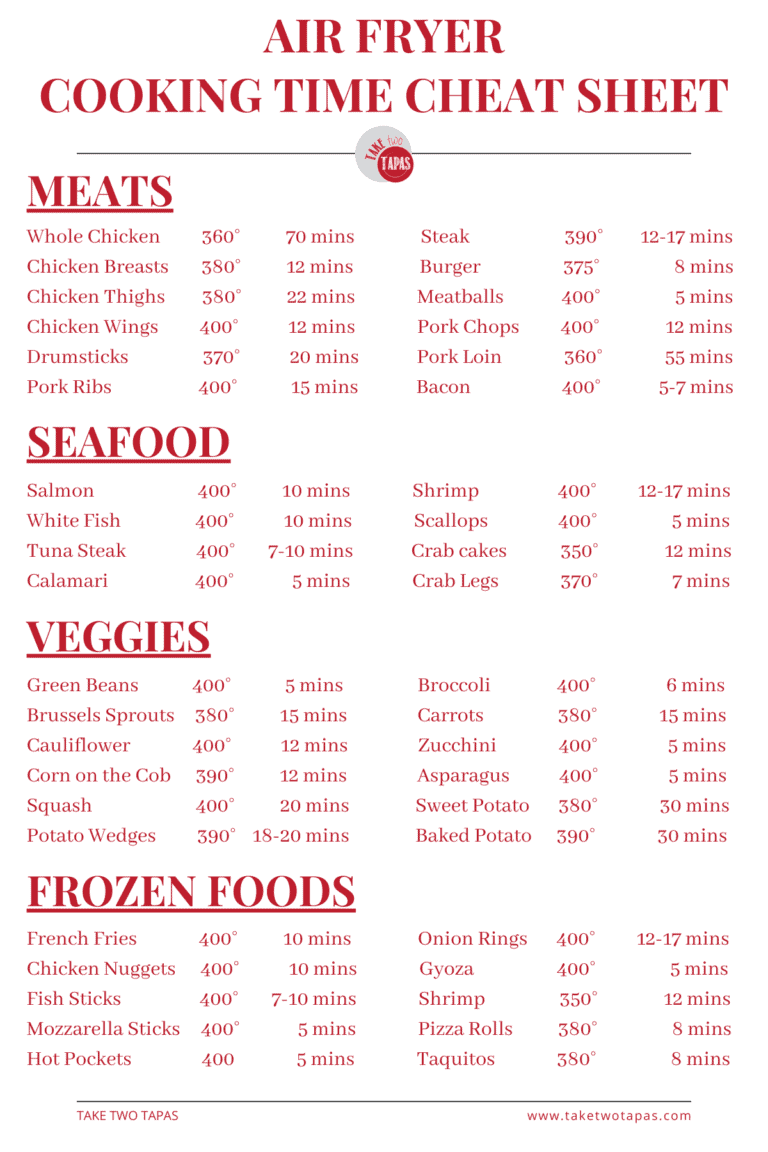5 Ways to Zest a Lemon
Lemon Zest is a great way to add brightness to your soups, salads, dressings, and desserts. Check out these easy ways to zest lemons with tools already in your kitchen.
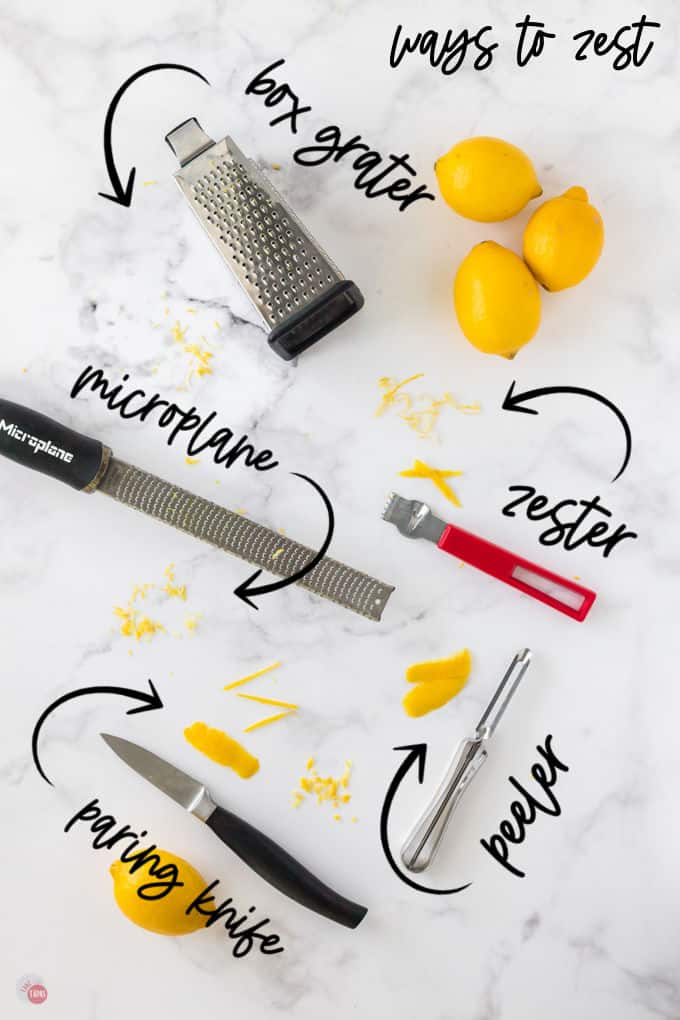
What is lemon zest?
Zest is essentially the peel of the lemon grated very fine. Not the whole peel, just the outermost part.
All citrus is covered with a peel. There are two parts to this peel. The inner section close to the fruit that is white.
This is the pith and acts as a protective coating keeping all the juice and flesh inside. This pith (white part) is bitter in flavor so you want to avoid this when zesting.
The outer layer which is colored and what you see when you look at the lemon is where all the magic happens.
It contains all the natural oils and thus all the yummy flavor. This is the part that you want to get when you zest, and avoid the rest.
The thickness of the peel (and the pith) can differ depending on the citrus. Oranges and grapefruits have thicker peels and piths while lemons and limes have thinner ones.
How much zest comes from one lemon?
A medium-sized one lemon can yield 1 tablespoon of zest. This can vary depending on how thoroughly you zest the lemon. The amount also varies depending on thickness of the citrus fruit.
One medium sized lemon = 1 tablespoon lemon zest
Uses for Lemon Zest
There are so many uses for citrus zest. My favorite uses are:
- dressings
- marinades
- rimming salt/sugar for cocktails
- flavored butters
- flavoring tea
- dessert frostings
- baked goods like cookies/muffins
- basically any recipe that calls for lemon flavor!
This post may contain affiliate links. As an Amazon Associate, I earn from qualifying purchases at no additional cost to you. Read my disclosure policy.
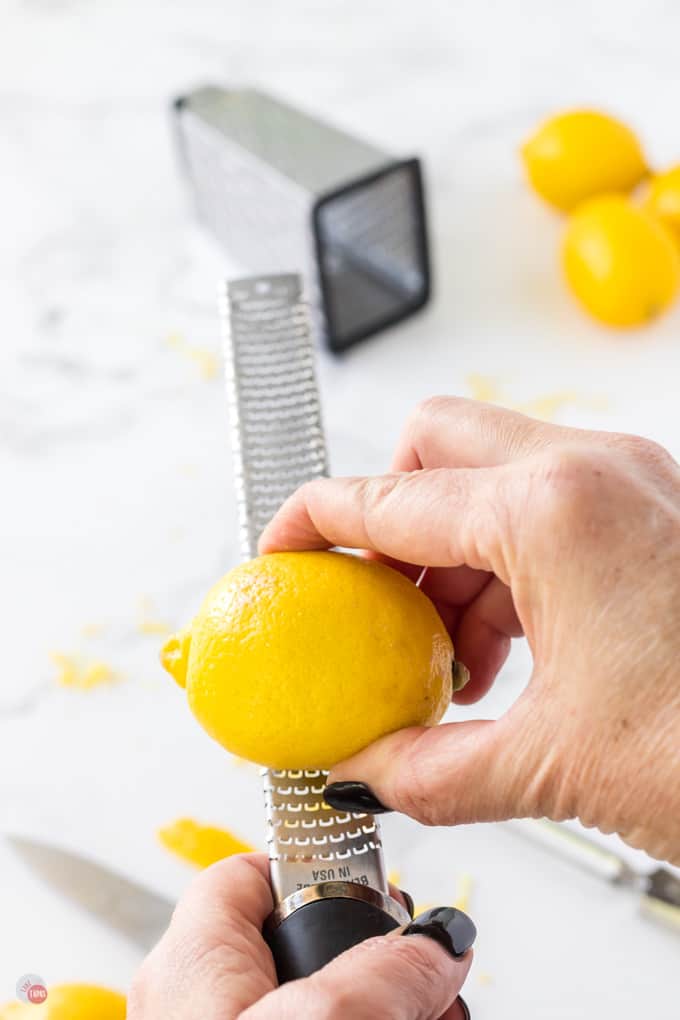
How to Zest a Lemon
There are a few different ways to zest a lemon. A few of these require a small kitchen gadget but you can get zest without them if you don’t already own one.
1. Microplane
This is my favorite way to zest my lemons. It’s long and easy to use and gets the zest super fine. This tool is very sharp so use with caution.
Hold the lemon in one hand and the microplane in the other. In a sweeping motion, drag the lemon across the sharp side of the grater, pushing down gently, removing the bright yellow peel, exposing the pith underneath.
Once you start to see white, rotate the lemon and continue zesting until you have all you need.
If the zest sticks to the underside of the grater, just give it a light tap on the counter or cutting board and it will dislodge and fall off. The zest is full of oils and moisture so it might stick to the grater.
For more insider tips, tricks, and a behind the scenes look, follow me on Pinterest, Facebook, Instagram, & X.
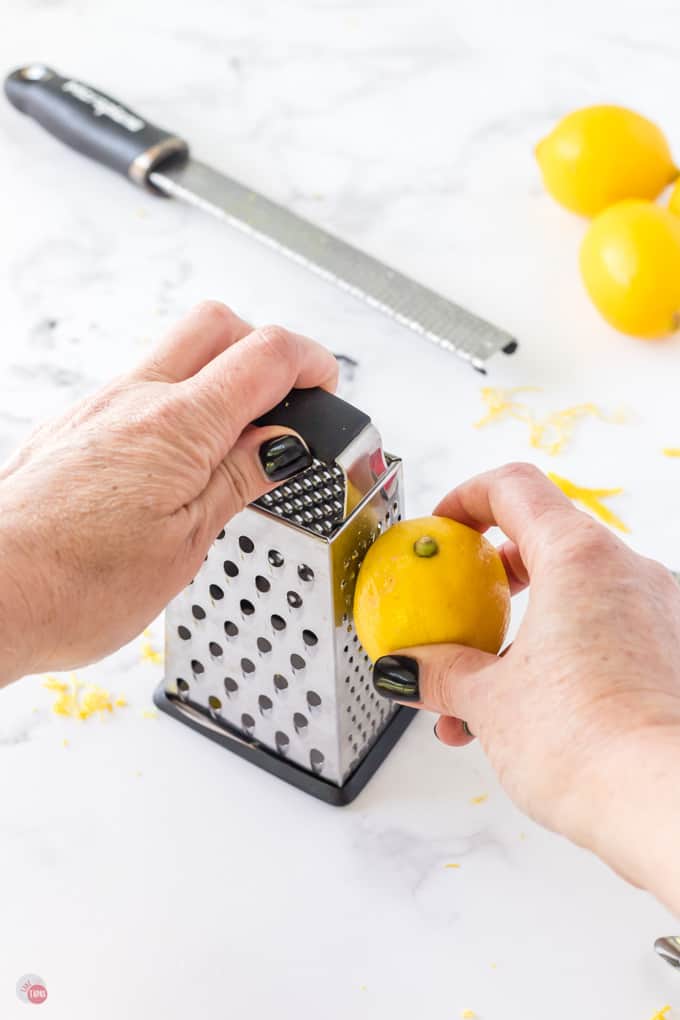
2. Box Grater
This is just as effective as a microplane and you probably have one of these in your kitchen right now.
For making zest, be sure to use the smallest holes on the grater.
Place the grater over a board or other flat work surface. Hold the box grater firmly with one hand, and with the lemon in the other, drag the lemon over the holes, pushing down gently to remove the yellow part of the peel.
Stop when you start to see white. Slightly rotate the lemon as you go and continue to zest until you remove all the yellow peel.
If the zest sticks to the inside of the grater, just tap the grater on the counter or use a spatula and scrape it out of the inside. Watch the sharp edges!
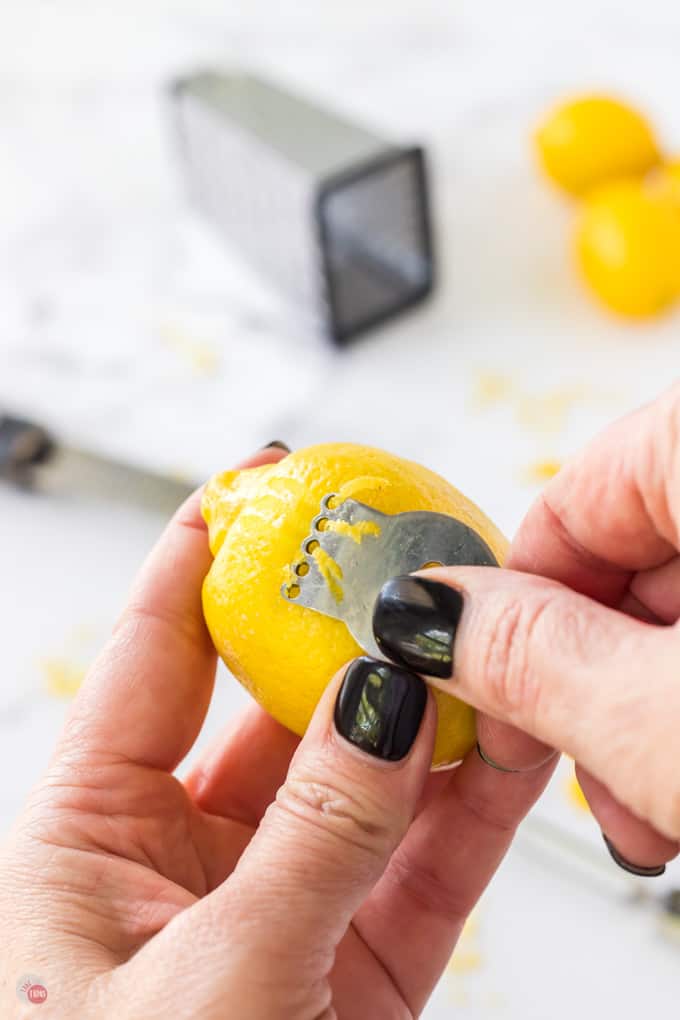
3. Zester
I am not one for a tool that only does one thing (or two) but I admit that I have one of these. It was a wedding present along with the melon baller 🙂
My lemon zester also has a channel knife, making it a two job tool, and is great if you like to garnish cocktails.
Start at the top of the lemon and press the holes down onto the peel and pull down. This zest will come in long thin strips, not like from the graters. Rotate as you zest to get all that you can.
The other part of the citrus zester is the channel knife. This is used to make long narrow strips of peel that you would use as a lemon twist for cocktails or swirls for topping desserts.
Dig the tip of the knife (looks like the end of a peeler) into the middle section of the lemon. You can continue to rotate the lemon and make one long strip of peel. I’m no that good but I can get them a few inches long.
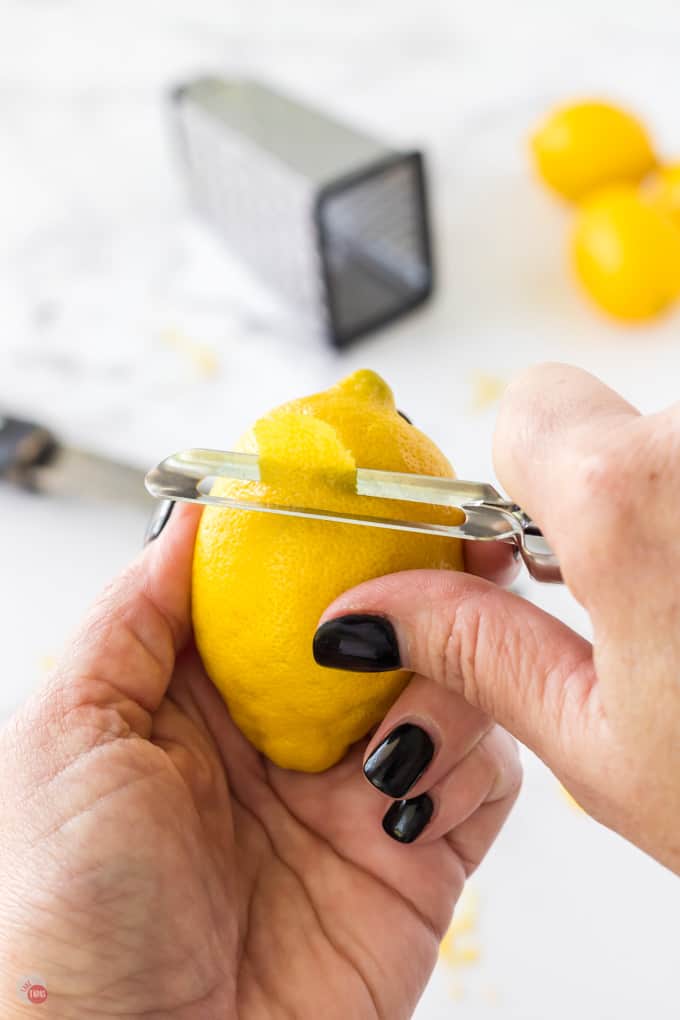
4. Vegetable Peeler
Use this to peel the lemon like you would a potato. Peel long, wide strips of lemon peel, being sure not to get any white pith on it.
Once you get the strips, you can cut them into very thin strips with a knife or chop into small pieces like zest.
5. Knife
Using a sharp knife like a paring knife, slice off thin layers of the outer lemon peel, leaving the pith.
Once you have the strips, slice into thin strips and finely chop into small pieces if necessary.
Lemon Zest Substitute
What if I don’t have fresh lemons to zest? What can I use instead?
For each teaspoon of lemon zest use the following:
- lime/orange zest – 1 teaspoon
- lemon juice – 2 tablespoons
- lemon extract – 1/4 teaspoon
- dried lemon peel – 1/3 teaspoon
How to Store Lemon Zest
Lemon zest can be stored in the refrigerator in a small jar or plastic bag for up to 2 weeks. If you want to store it longer I recommend freezing it.
To freeze lemon zest, spread it out on piece of parchment paper and freeze. Once frozen, transfer to a freezer container or zip top bag and store frozen until ready to use.
Frozen lemon zest will last up to 6 months!!
Tapas Tips & Tricks
- the lemon will harden quickly if you zest it and don’t use it.
- wash the citrus first. You are using the part of the lemon that everything touches.
- be careful that you don’t cut in too deeply; your goal is to get the shallowest slice possible.
- once zested, don’t waste the lemon. Juice it and freeze the juice!
- wear gloves or make sure your hands don’t have cuts or you will feel the burn.
- wash hands after zesting as the lemon oil can cause irritation to the skin.
- after zesting, cut them into lemon wedges.

More Easy Appetizers

How to Zest a Lemon
Equipment
Ingredients
- 1 lemon
- zester
Instructions
Microplane
- Hold the lemon in one hand and the microplane in the other. In a sweeping motion, drag the lemon across the sharp side of the grater, pushing down gently, removing the bright yellow peel, exposing the pith underneath.
- Once you start to see white, rotate the lemon and continue zesting until you have all you need.
- If the zest sticks to the underside of the grater, just give it a light tap on the counter or cutting board and it will dislodge and fall off. The zest is full of oils and moisture so it might stick to the grater.
Box Grater
- For making zest, be sure to use the smallest holes on the grater.
- Place the grater over a board or other flat work surface. Hold the box grater firmly with one hand, and with the lemon in the other, drag the lemon over the holes, pushing down gently to remove the yellow part of the peel.
- Stop when you start to see white. Slightly rotate the lemon as you go and continue to zest until you remove all the yellow peel.
- If the zest sticks to the inside of the grater, just tap the grater on the counter or use a spatula and scrape it out of the inside. Watch the sharp edges!
Citrus Zester
- Start at the top of the lemon and press the holes down onto the peel and pull down. This zest will come in long thin strips, not like from the graters. Rotate as you zest to get all that you can.
- The other part of the citrus zester is the channel knife. This is used to make long narrow strips of peel that you would use as a lemon twist for cocktails or swirls for topping desserts.
- Dig the tip of the knife (looks like the end of a peeler) into the middle section of the lemon. You can continue to rotate the lemon and make one long strip of peel. I’m no that good but I can get them a few inches long.
Vegetable Peeler
- Use this to peel the lemon like you would a potato. Peel long, wide strips of lemon peel, being sure not to get any white pith on it.
- Once you get the strips, you can cut them into very thin strips with a knife or chop into small pieces like zest.
Knife
- Using a sharp knife like a paring knife, slice off thin layers of the outer lemon peel, leaving the pith.
- Once you have the strips, slice into thin strips and finely chop into small pieces if necessary.
Notes
Nutrition
©TakeTwoTapas.com. Content and photographs are copyright protected. Sharing of this recipe is both encouraged and appreciated. Copying and/or pasting full recipes to any social media is strictly prohibited.




